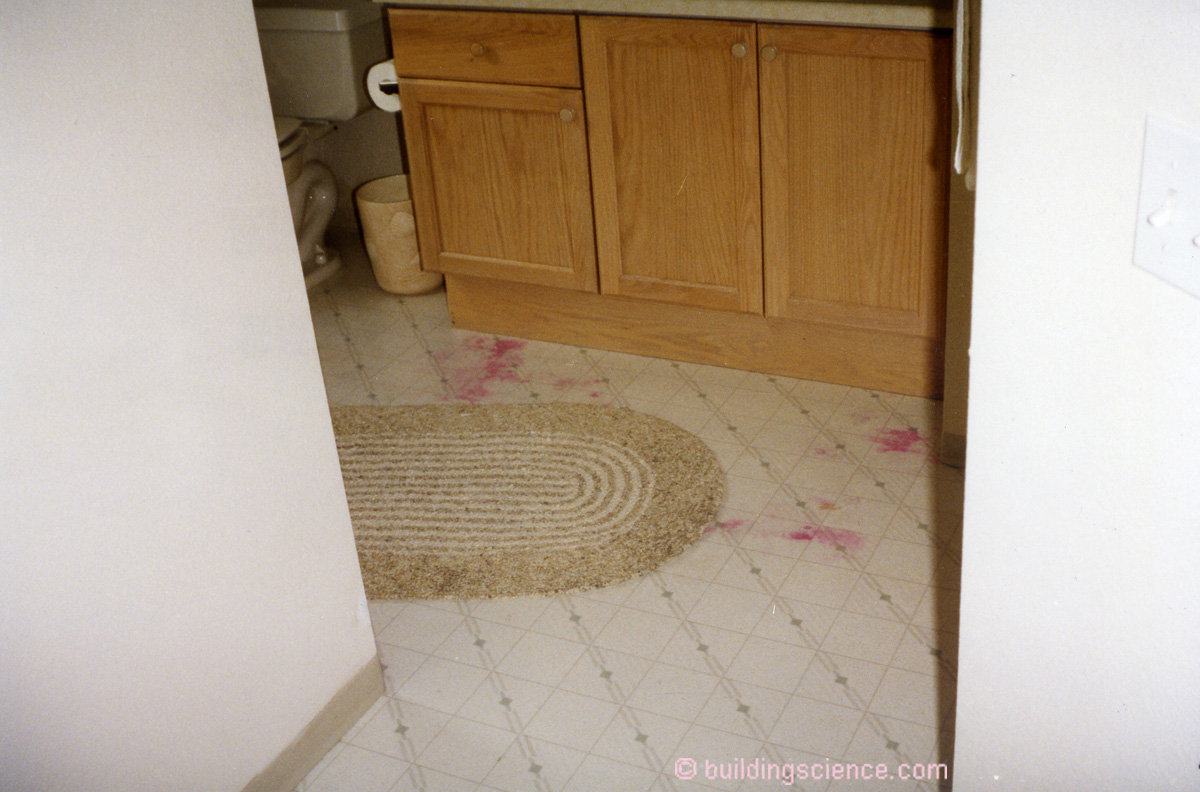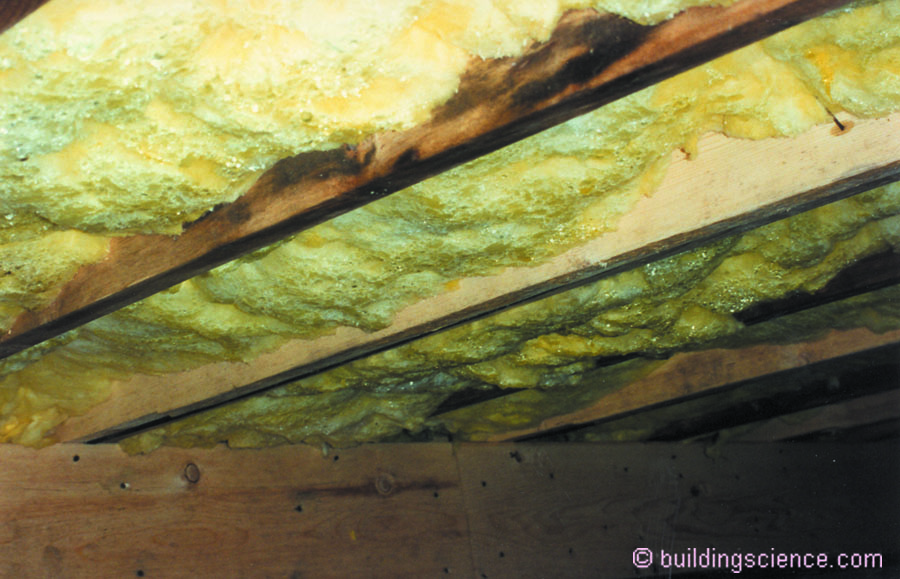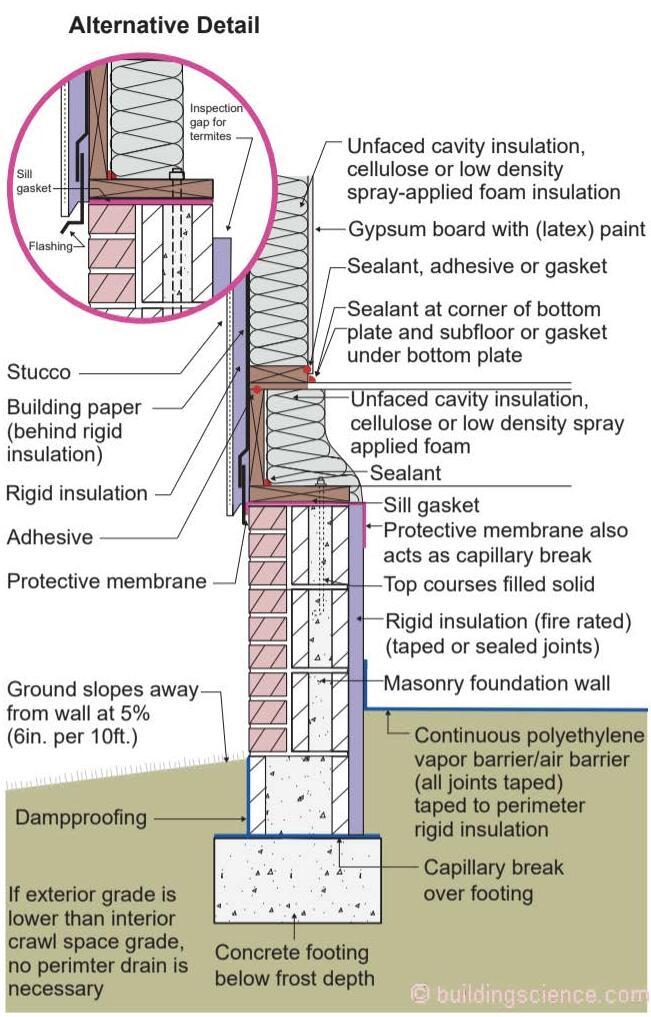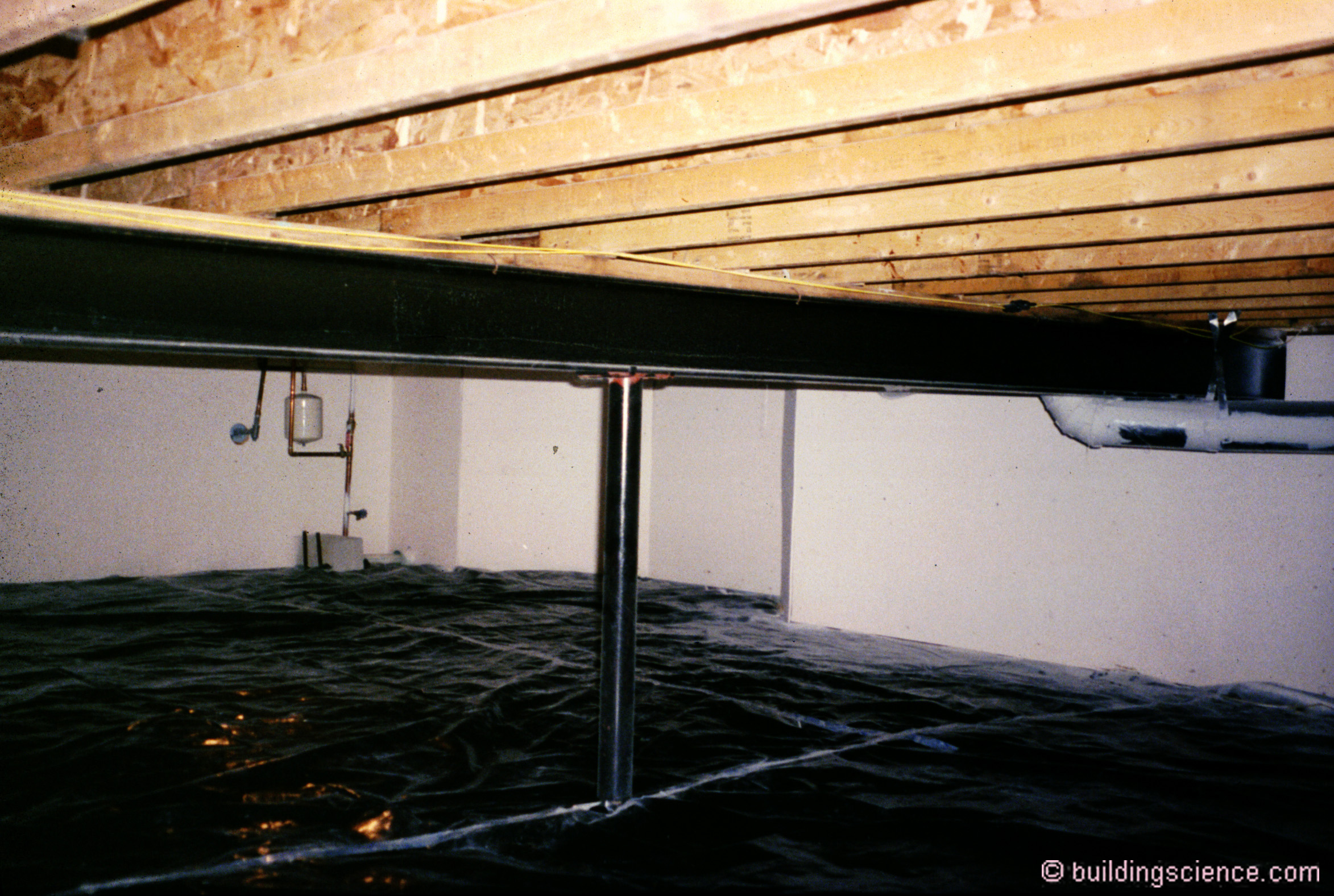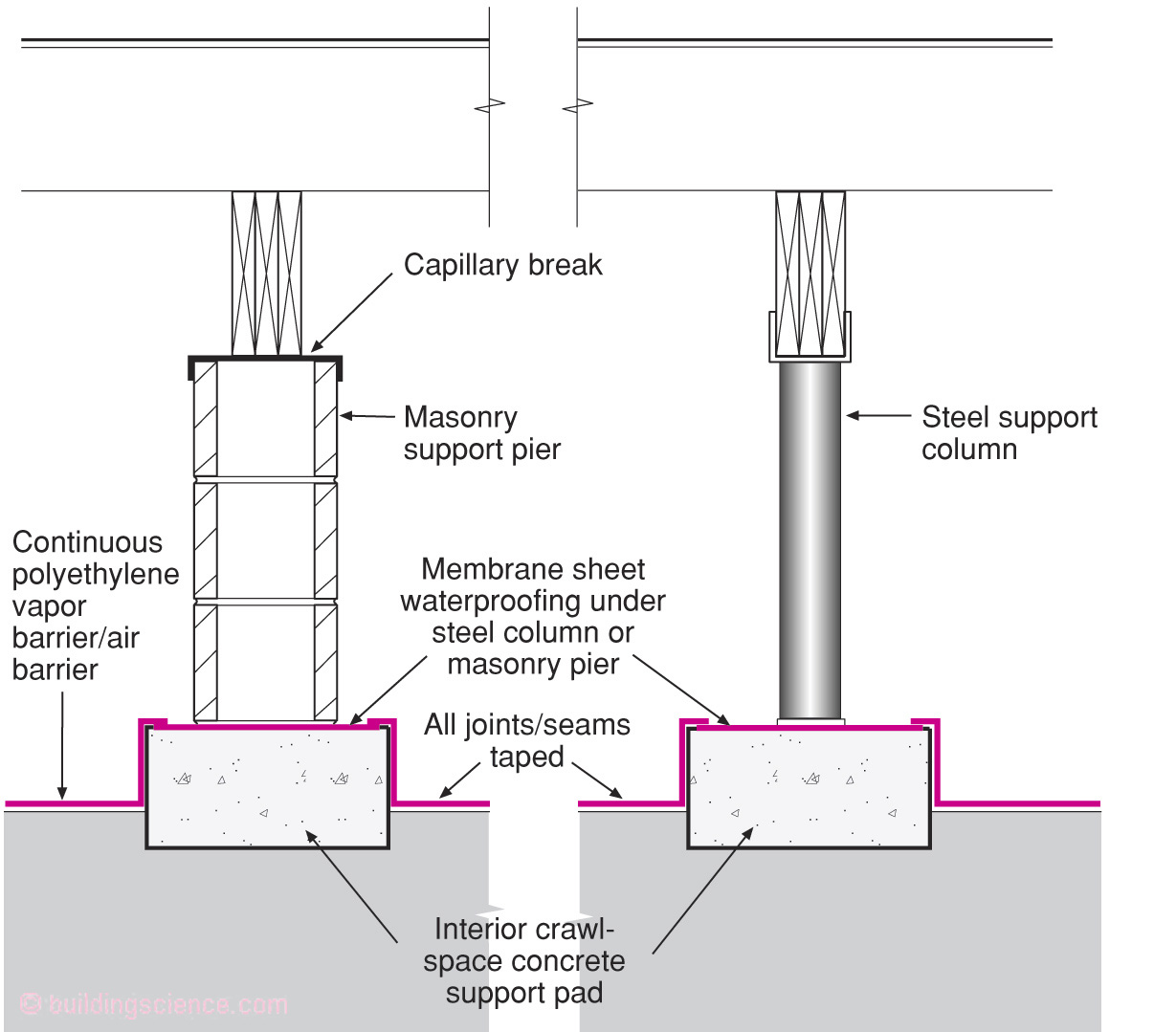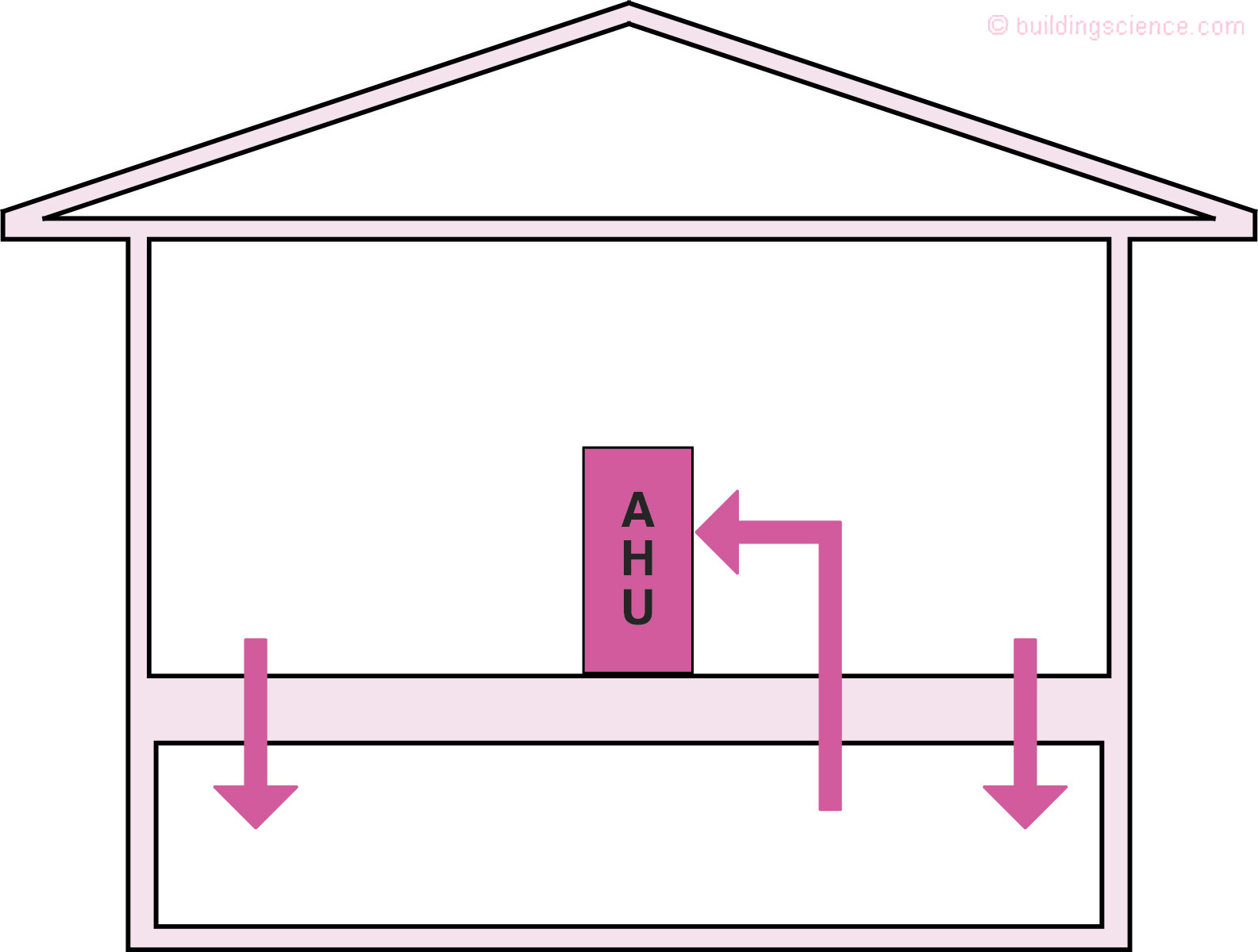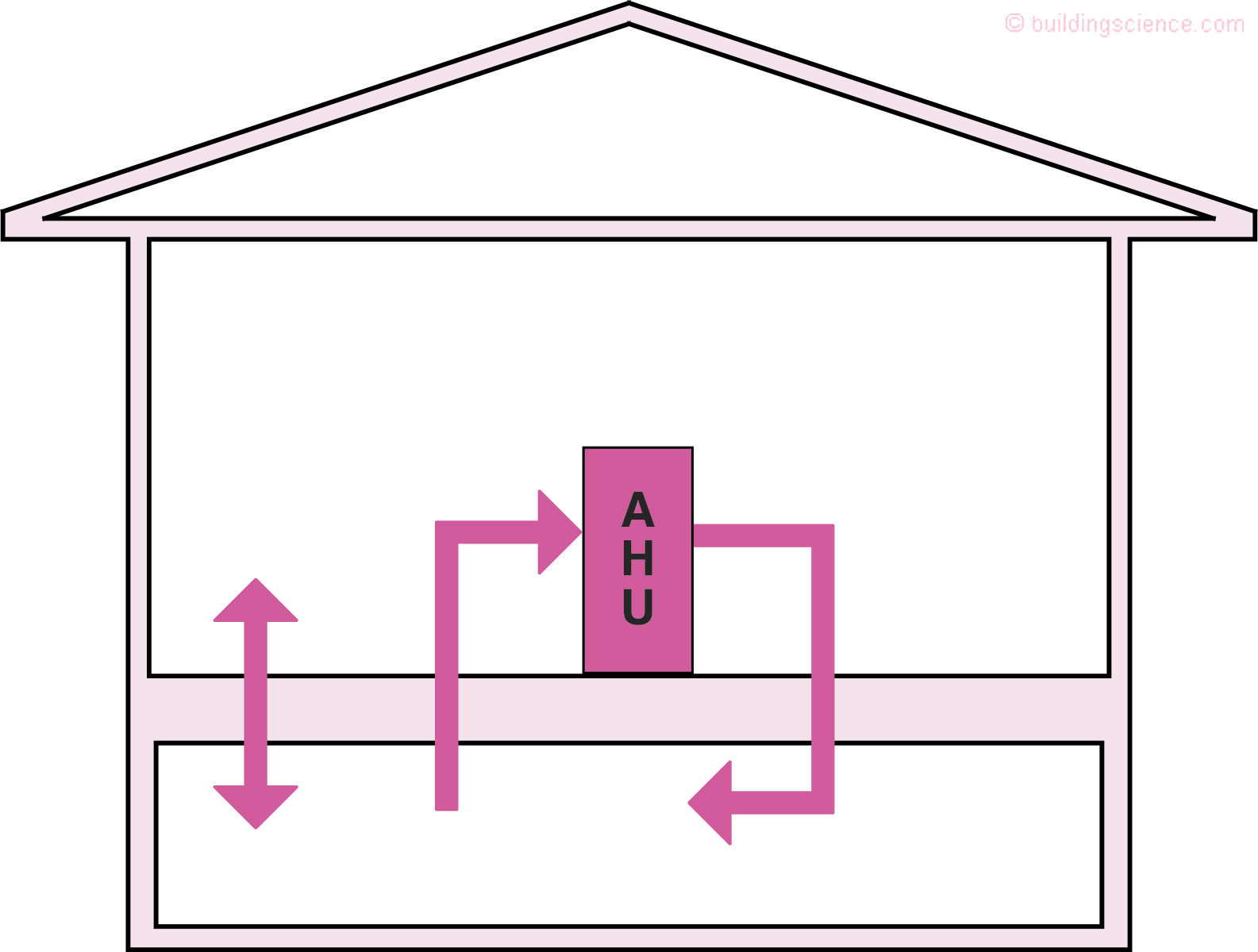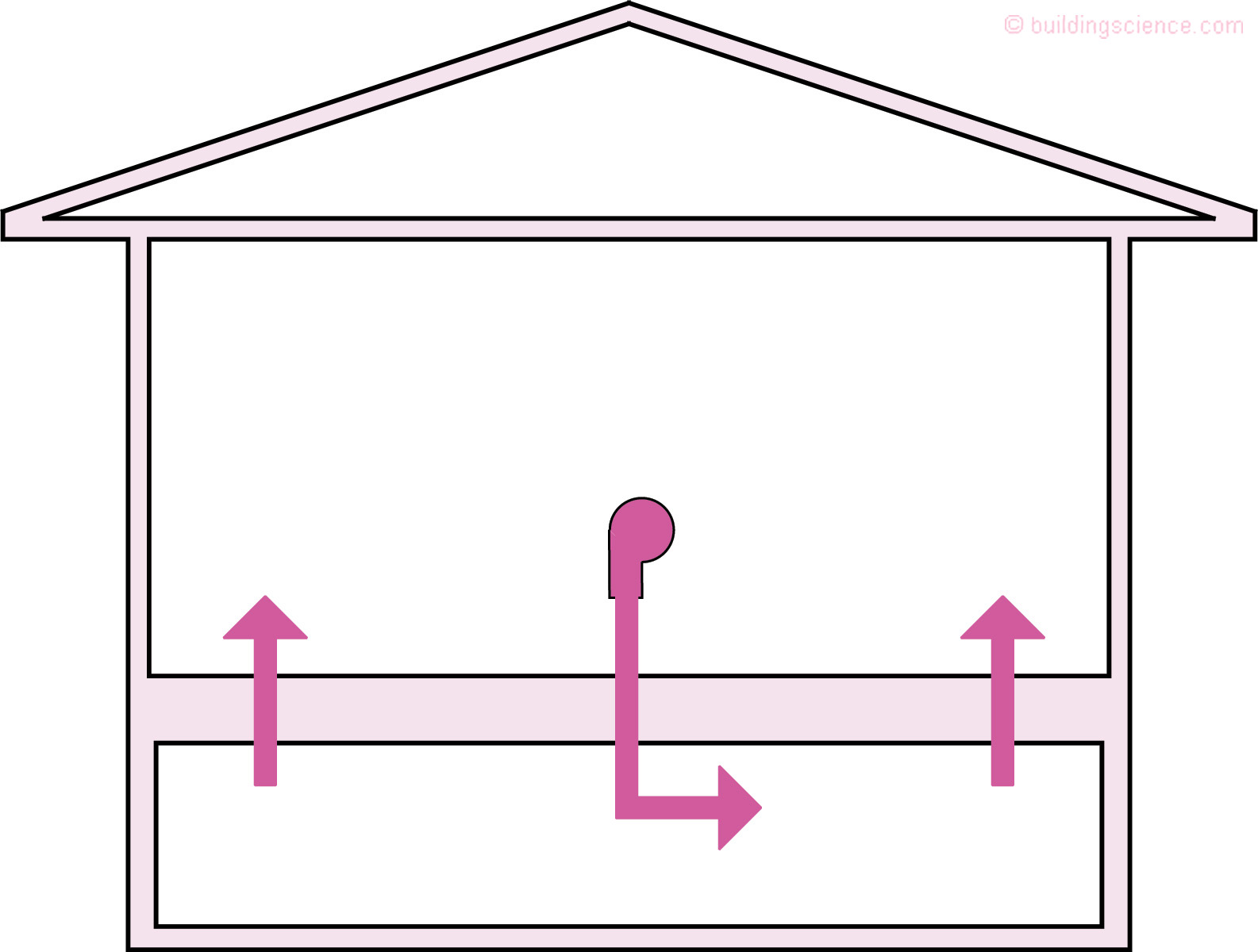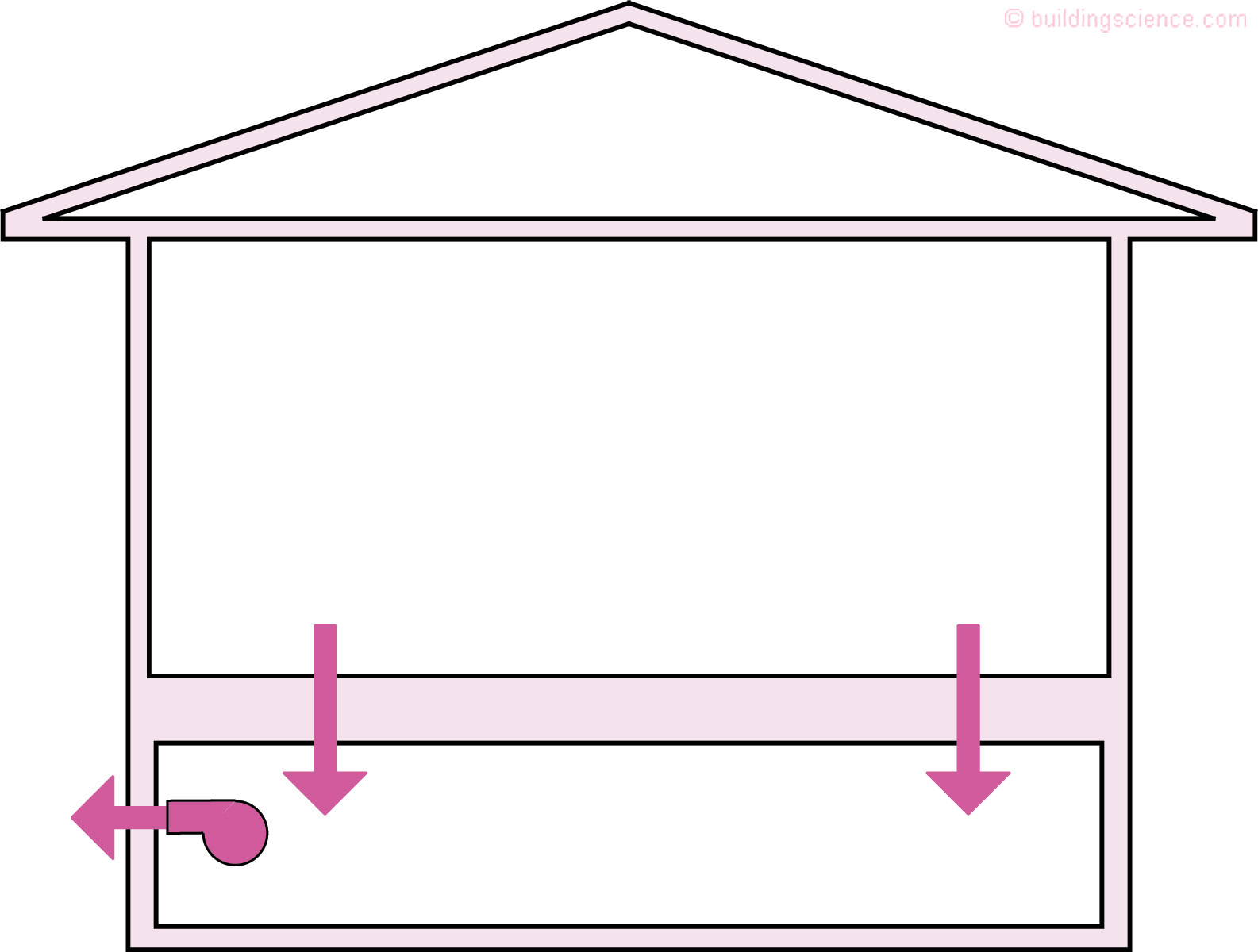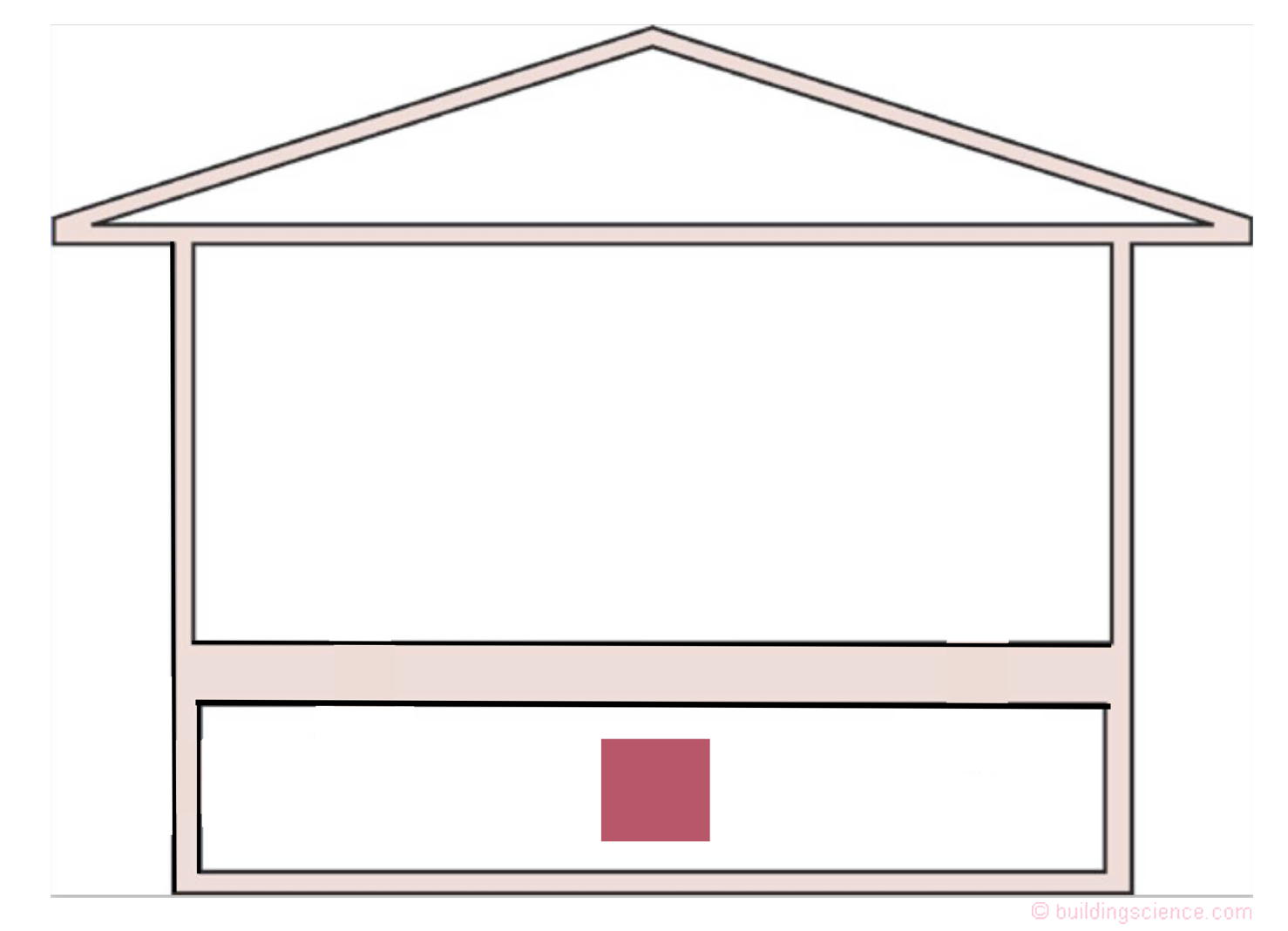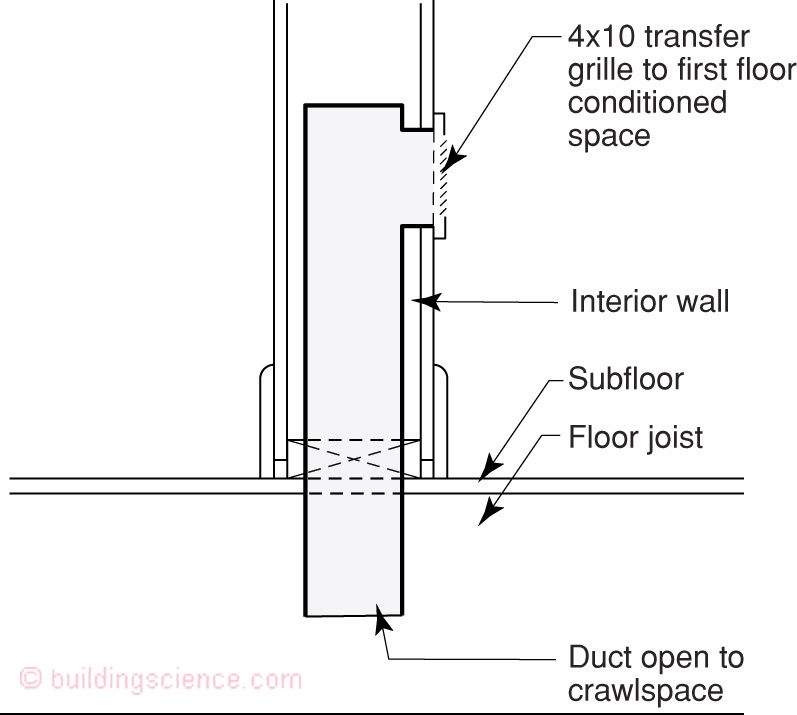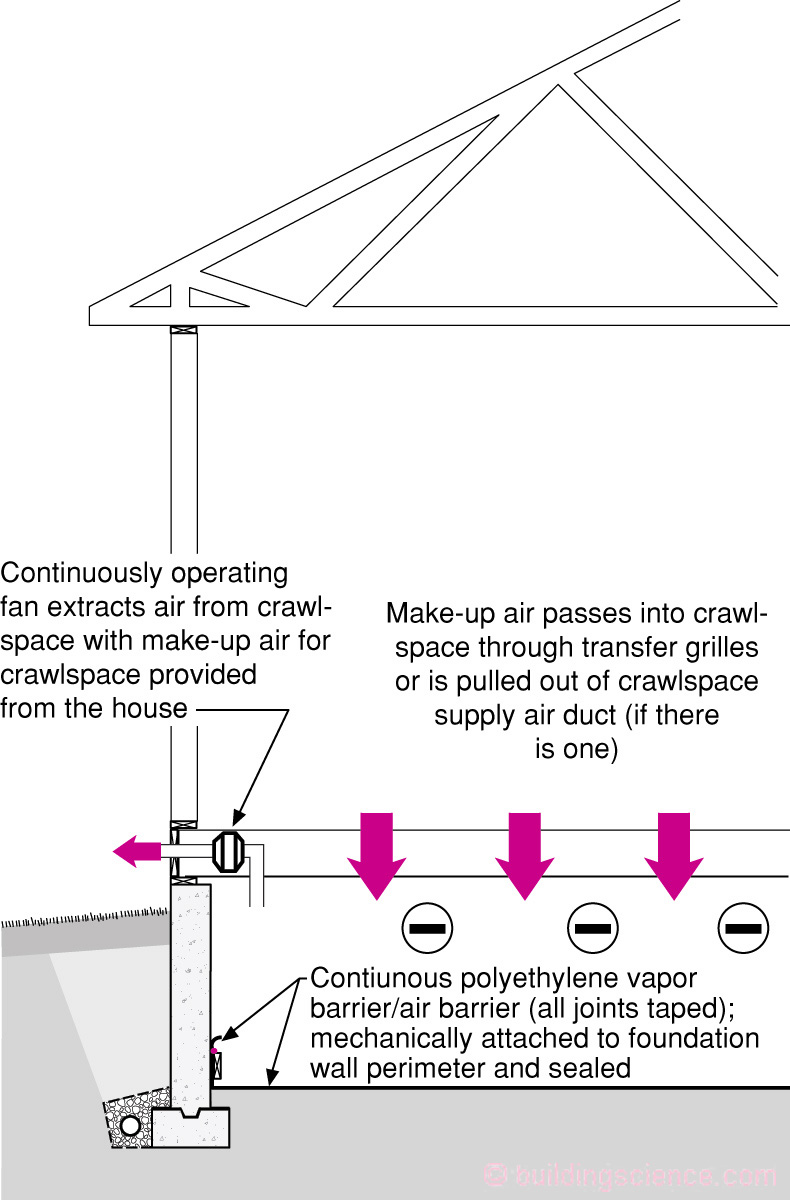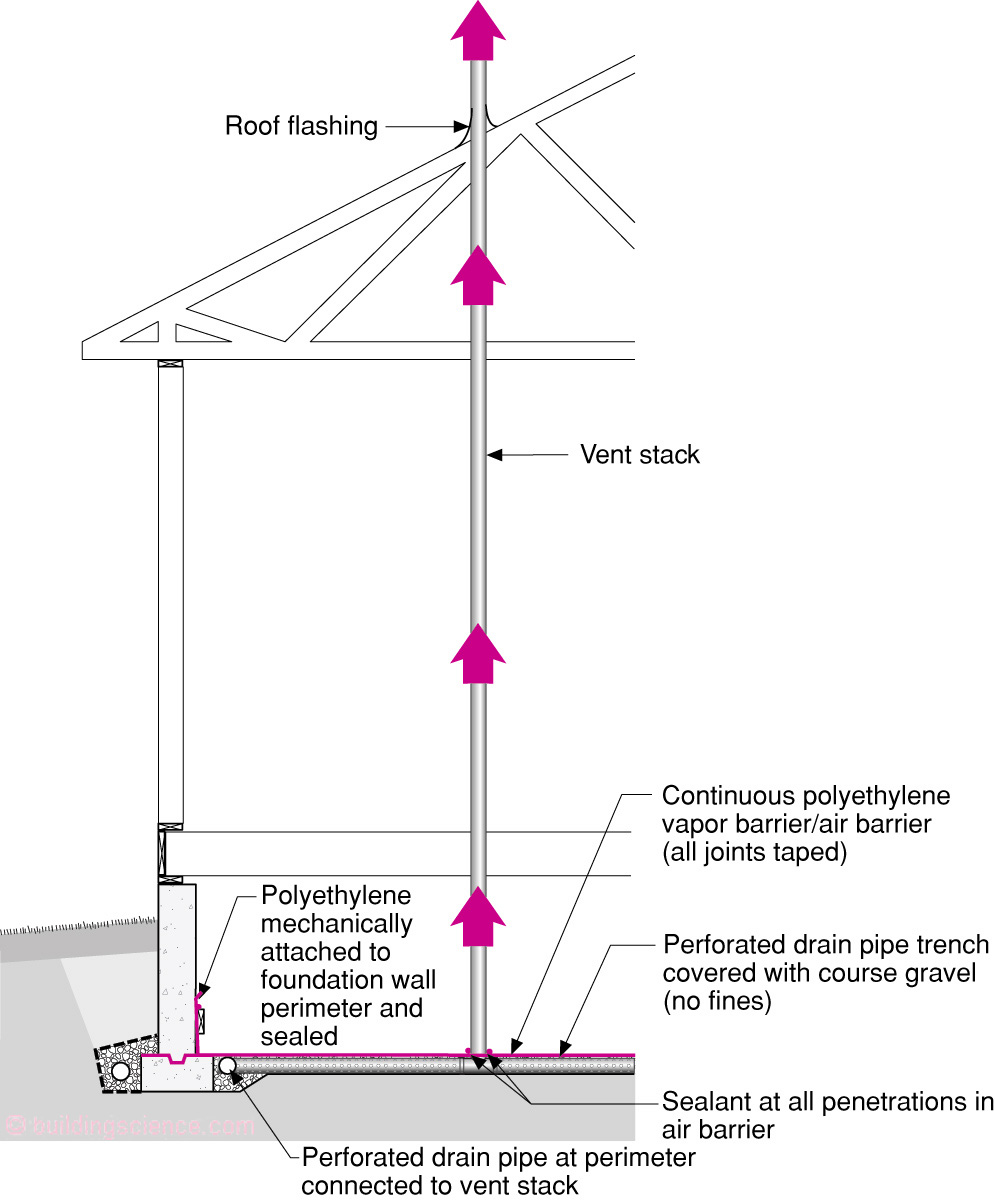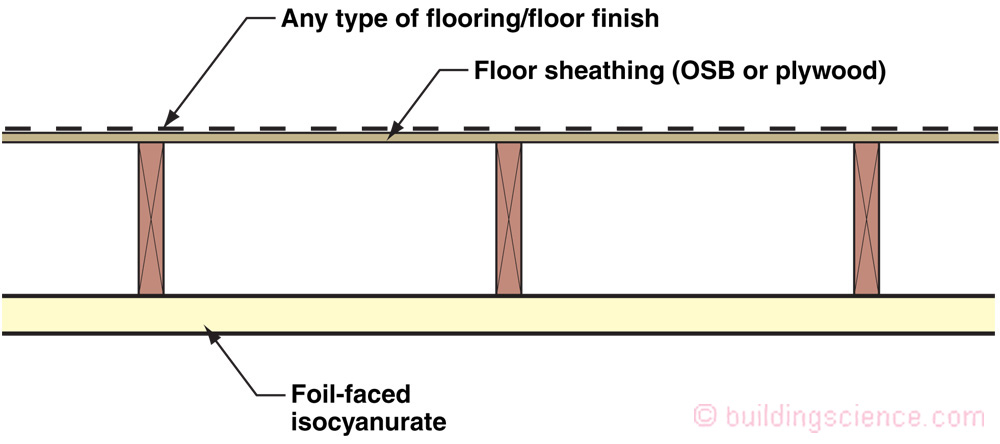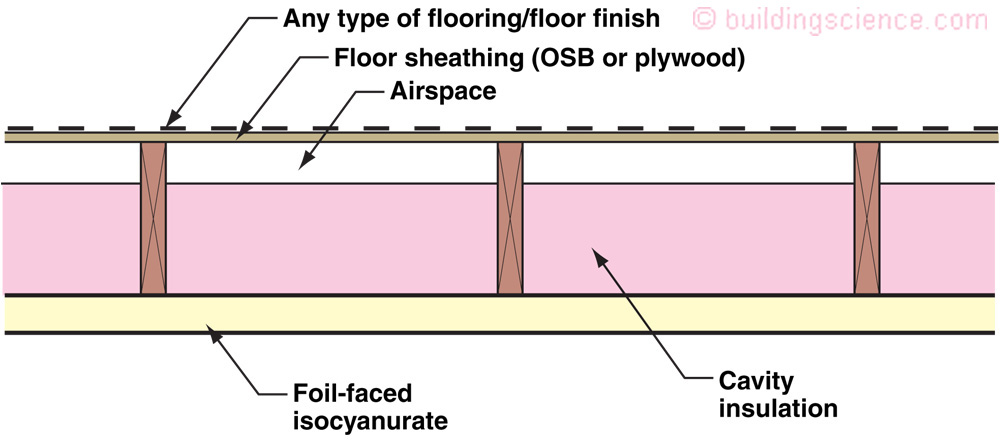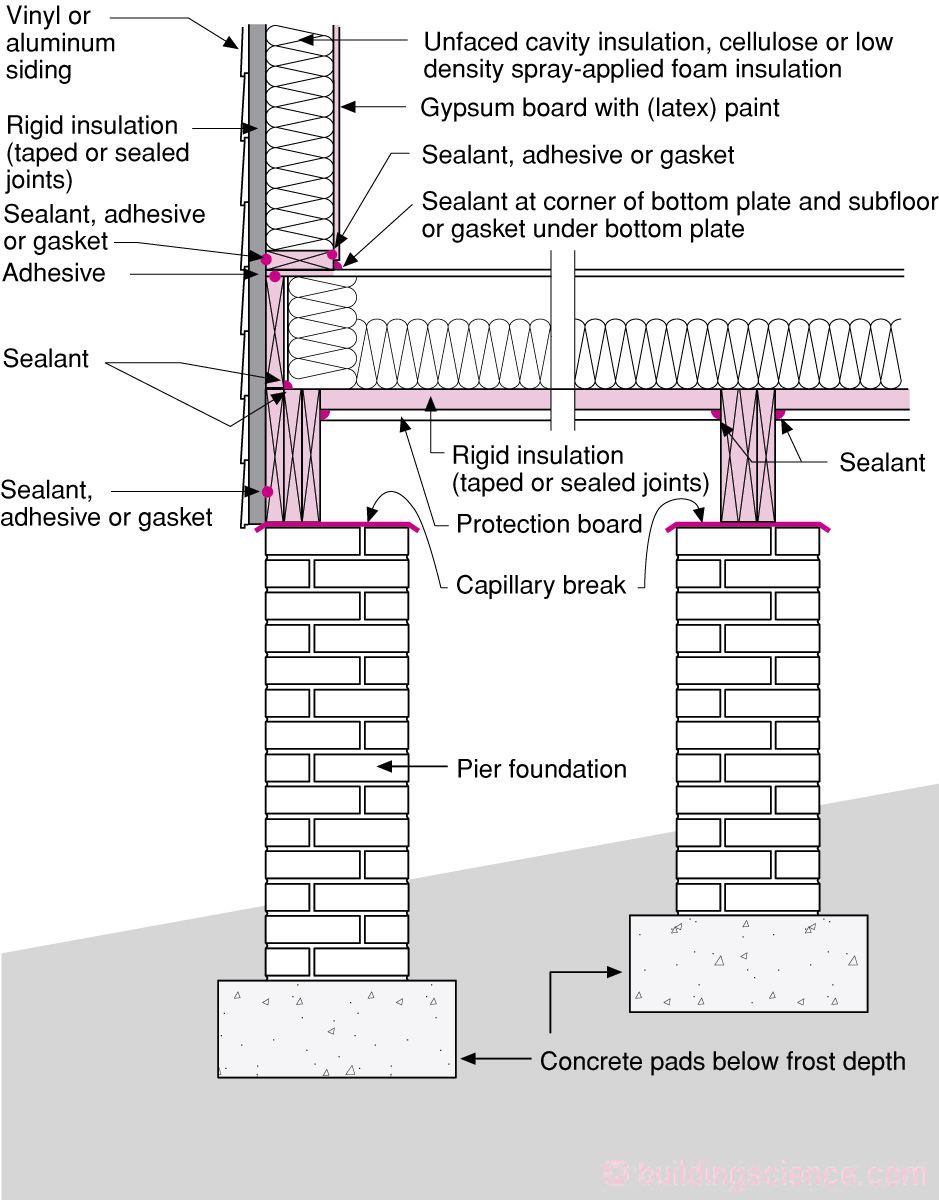Crawlspaces continue to be a mess ever since we decided to insulate them and put air conditioned buildings on top of them1. We were here before (BSI-009: “New Light in Crawlspaces”, May, 2010)…but we have to come back. We are continuing to see buckled wood floors over crawlspaces and moldy vinyl floor coverings (Photograph 1). You can’t solve the problem building vented crawlspaces with “fluffy” stuff smushed into floor joists (Photograph 2).
Photograph 1: Vinyl Flooring – Pink spots due to moisture problems arising from the impermeability of the vinyl flooring and ventilated and insulated crawlspace underneath.
Photograph 2: Typical Vented Crawlspace -Note the condensation on the underside of the fiberglass insulation and the rot at the exposed portions of the crawlspace floor joists.
The crawlspace thing shouldn’t be difficult. There is only really one big thing that has to be done. Here goes….hold your breath. They should either be inside the house or outside the house…not in between. They need to be completely, totally, for sure, no doubt not connected to the house (or building)…or be completely, totally, for sure, no doubt connected to the house (or building). Either the house does not “see” the crawlspace or the crawlspace does not “see” the house …or the crawlspace does not “see” the outside and only “sees” the house (i.e. “the inside”).
You have to connect the crawlspace to the house…or disconnect the house from the crawlspace. I think I have said the same thing a bunch of different ways….OK….one more. The crawlspace is either “vented” and “not conditioned” and connected to the “outside”…or…the crawlspace is “not vented” and “conditioned” and connected to the “inside”.
When crawlspaces are connected to both the outside and the inside ugly things happen.
Let’s do the obvious one first. Build them like “mini” basements where they are completely connected to the house (or building). With this approach any floor finish or floor covering works…wood floors, tile floors, vinyl flooring…all of them work. The key to this approach to crawlspaces is that they are “conditioned". I hate the term “unvented crawlspaces”2…“unvented” implies that you just don’t install vents. Wrong. Big time wrong. There has to be a means of removing moisture from the crawlspace when the crawlspace is connected to the house just like there has to be a means of removing moisture from any room in the house. In the rooms and spaces in houses we do it with controlled air change during heating seasons and dehumidification via air conditioning (or via a dehumidifier) during cooling seasons. Houses are “conditioned” and conditioning means controlling temperature and relative humidity.3
So what does a conditioned crawlspace look like? Check out Figure 1 and Photograph 3. It is insulated on the interior with rigid insulation. It has a continuous vapor impermeable ground cover….do not forget the columns and posts (Figure 2). It is air sealed isolating it from the exterior air and the ground below. Now for the conditioning part…folks tend to forget this part. You have to provide air change between the crawlspace and the house or you have to provide dehumidification. The building code calls for 50 cfm per 1,000 ft2(approximately 25 l/s per 100 m2) of supply air or dehumidification.
Figure 1: Conditioned Crawlspace - It is insulated on the interior with rigid insulation. It has a continuous vapor impermeable ground cover. Note the termite inspection gap for you North Carolina folks….
Photograph 3: Conditioned Crawlspace – The way crawlspaces should look. Dry, warm, part of the house, not part of the outside or part of the ground. Insulated on the perimeter not in the floor. Beautiful.
Figure 2: Columns and Piers – Ground covers need to be continuous across intermediate structural supporting members.
So how do you do the conditioning? There are 6 typical ways (maybe more) of doing it (Figure 3a, 3b, 3c, 3d, 3e and 3f). When you supply air to the crawlspace from an air conditioner or furnace (Figure 3a) there needs to be a way for air to come back to the house…besides poor workmanship. A transfer grille is recommended (Figure 4). If you pull air out of the crawlspace with a return duct (Figure 3b) there needs to be a way for air to get from the house to the crawlspace….yes a transfer grille is recommended.
Figure 3a: Supply Air to Crawlspace - When you supply air to the crawlspace from an air conditioner or furnace there needs to be a way for air to come back to the house…besides poor workmanship. A transfer grille is recommended.
Figure 3b: Return Air from Crawlspace - If you pull air out of the crawlspace with a return duct there needs to be a way for air to get from the house to the crawlspace. A transfer grille is recommended.
Figure 3c: Supply and Return Air to and from Crawlspace - If you supply and return air to the crawlspace from an air conditioner or furnace you need a way to balance the air flows to avoid pressure differences. A transfer grille is recommended.
Figure 3d: Supply Fan to Crawlspace - Do you not need a furnace or air conditioner with ducts to condition crawlspaces. You can do it with a supply fan…but you still need a pathway back to the house. A transfer grille is recommended.
Figure 3e: Exhaust Fan from Crawlspace – You can use an exhaust fan to pull air out of the crawlspace and exhaust this air to the exterior pulling make-up air for the crawlspace from the house.
Figure 3f: Crawlspace Dehumidifier - If conditioning crawlspaces with air from the house is not desirable install a dehumidifier. The dehumidifier handles the moisture control.
If you supply and return air to the crawlspace from an air conditioner or furnace (Figure 3c) you need a way to balance the air flows to avoid pressure differences….yes a transfer grille is recommended. So how are air flows balanced in Figure 3a and Figure 3b? The transfer grilles make it happen….they adjust for the flow rates….
Do you need a furnace or air conditioner with ducts to condition crawlspaces? Nope. You can do it with a supply fan (Figure 3d)….but you still need a pathway back to the house…yup…transfer grilles again.
Let’s look at Figure 3e. Can you use an exhaust fan to pull air out of the crawlspace and exhaust this air to the exterior pulling air from the house? Yes. You can vent the house through the crawlspace….exhaust only ventilation with make-up air supplied to the crawlspace from the house (Figure 5).4
Figure 4: Transfer Grille – Best location is in an interior wall thereby avoiding floor grilles that can be blocked with furniture and that can lead stuff falling into crawlspaces.
Figure 5: Venting House Through Crawlspace - You can vent the house through the crawlspace….exhaust only ventilation with make-up air supplied to the crawlspace from the house. This is a variation of exhaust only house ventilation.
What if I do not want to do this conditioning with air from the house? OK, check out Figure 3f. Install a dehumidifier. The dehumidifier handles the moisture control.5
What about radon and other soil gases? Yes, they need to be also addressed. The best approach is the typical sub slab…sub poly “radon vent” (Figure 6).
Figure 6: Radon/Soil Gas Vent - Radon and other soil gases need to be addressed with conditioned crawlspaces just as they need to be addressed in basements. The best approach is the typical sub slab…sub poly “radon vent”.
Now for the not so obvious one. It should be obvious but it is not. How do you construct a vented crawlspace without causing moisture problems? Here is where I point out that conditioned crawlspaces are more energy efficient than vented crawlspaces and your first best choice is to go the mini basement approach. But maybe you can’t construct a conditioned crawlspace. Hey, maybe you need to construct a vented crawlspace because you are in a flood zone – or you live over a swamp….like most of the state of Florida or the fun parts of Louisiana.
Vented crawlspaces become worse when impermeable floor finishes are used such a vinyl flooring as pointed out earlier. Can we safely and reliably install wood flooring and vinyl flooring over plywood and OSB subflooring over vented crawlspaces? Yes. We just need to keep the air and vapor out of the crawlspace floor framing.
Check out Figure 7 and Figure 8. Both show foil faced rigid insulation under the floor framing. The wood is warm and therefore dry – during both winter and summer. The foil facing on the rigid insulation handles the vapor drive. The foil facing is an exceptional vapor barrier (< 0.1 perm). Beautiful. With the impermeable rigid insulation even relatively impermeable floor coverings such as vinyl flooring work.
So why don’t we see lots of this? Well, I forgot to mention that the rigid insulation needs to be airtight so that requires good workmanship to seal the seams with foil tape that sticks in miserable environmental conditions forever. Having said that, a poor job using the approaches described in Figure 7 and Figure 8 are way better than what we typically get with Photograph 2.
Figure 9 and Figure 10 show the perimeter details – connecting the underside of the crawlspace floor framing through the perimeter rim joist area to the exterior wall assemblies.
Being the nervous conservative old guy I have become I worry about critters getting into the rigid insulation and pretty much always recommend some type of protection board over the underside of the rigid insulation. Fibercement boards work well in this regard (Figure 10).
Figure 7: Vapor Barrier – Installing impermeable rigid insulation keeps the wood framing warm and provides a low perm layer that addresses the upward vapor drive. How impermeable? Less than 0.1 perms. Foil faced rigid insulations are the ticket here. This approach allows any type of flooring to be used above. The rigid insulation also needs to be airtight.
Figure 8: Cavity Insulation with Vapor Barrier - Adding impermeable foil faced insulating sheathing over fiberglass cavity insulation is a hybrid approach that uses the best qualities of both materials. Note that the optimum location for the airspace is above the cavity insulation. Makes for warmer floors – this is the same detail that should be used under bedrooms over garages. Note that the rigid insulation also needs to be airtight.
Figure 9: Crawlspace Perimeter – It is necessary to connecting the underside of the crawlspace floor framing through the perimeter rim joist area to the exterior wall assemblies in an airtight manner.
Figure 10: More Crawlspace Perimeter - Being the nervous conservative old guy I have become I worry about critters getting into the rigid insulation and pretty much always recommend some type of protection board over the underside of the rigid insulation. Fibercement boards work well in this regard.
1 If the crawlspace floor joist cavities were not insulated the floor framing was receiving heat from the building above raising the temperature of the floor framing several degrees above the ground temperature in the crawlspace….if the buildings above crawlspaces were not air conditioned the floor framing remained warm. Air conditioned buildings with insulated crawlspace floor framing made the floor framing colder and the subfloors colder and moisture problems became inevitable. Buildings could sometimes survive insulation and no air conditioning….or no insulation and air conditioning…but rarely both.
2 I also hate the term “unvented attics” for similar reasons. And yes we were here before (BSI-083: “Mea Culpa Roofs”, December 2014).
3 Among other things such as controlling contaminants, sound, light, vibration….
4 This is a powerful approach when houses with moldy crawlspaces are retrofitted….sometimes there are limited funds available to completely decontaminate a moldy crawlspace. Continuously depressurizing the crawlspace relative to the house uncouples the crawlspace from the house. Of course the original moisture problem causing the crawlspace mold needs to be addressed. An exhaust fan does not solve ground water problems. But installing a ground cover, sealing crawlspace vents and running an exhaust fan to the exterior does address most other issues.
5 We condition unvented attics with dehumidifiers all the time….works pretty much the same way with crawlspaces.

